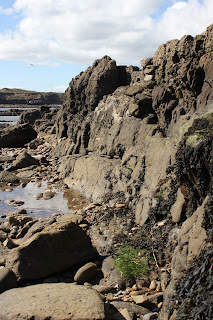In my 29 years I've never visited the place which is unusual with it being so close. Even a few people I had spoke to that were travelling through or on holiday in the region were surprised I'd never visited. Saying that most people probably travel further a field to visit places rather than what's on their door step.
Very friendly staff that are full of information and a good history lesson. I chatted to quite a few of them for a good 10 minutes before carrying on snapping away. Also the church of our lady was open the day I visited, beautiful little church with plenty of history and stories behind its building and extending that's happened since it was built in the 12th century.
Below is a brief history on Seaton Deleval Hall and the Church of our Lady. Enjoy the read!
The Deleval Family had owned the estate since the time of the Norman Conquest. Admiral Deleval purchased the estate from an impoverished kinsman, Sir John Deleval. George Deleval had made his fortune from capturing prize ships while in the Navy, and also served as a British envoy during the reign of Queen Anne. In 1718, he called on architect Sir John Vanbrugh to advise him on how to modernise and enhance the existing mansion. Upon viewing the site, Vanbrugh felt he could do nothing, and advised complete demolition of all except the ancient chapel near to the mansion, which is now the parish church or Our Lady.
His advise was taken and the construction work was completed in 1728, two years after the death of the admiral. The resulting new mansion was the last country house Vanbrugh designed, and it is regarded as his finest work. On completion, the admiral's nephew Francis Blake Deleval (the elder) inherited the property, and moved in immediately.
In 1775, the Newcastle portrait artist William Bell made two paintings of the hall, depicting the north and south fronts. Bell also painted portraits of many other residents of the houseat the time, earning earning him the patronage of Lord Deleval, a younger son of the above-mentioned Francis Blake Deleval. These paintings can still be seen in the Hall today.
In 1882, the central block was gutted by a fire said to have been caused by jackdaws nesting in the chimneys of the section of the south east-wing closest to the main house. This wing was subsequently demolished, and various openings can still be seen, now glazed, showing where it joined the central block.
The house was partially restored by the architect John Dobson in 1862-63, when the central block was re roofed, although it remained a shell internally, the effects of the fire remain clearly visible in the great hall, originally 30 feet but now open to the roof, with blackened walls and muse statues.
During the second World War the Hall was used to house German prisoners-of-war, who worked as labourers on neighbouring farms.
RECENT TIMES
Subsequently the 23rd Baron Hasting, Deleval Astley, wishing to preserve the future of the Hall and encourage greater public access, began discussions with the National Trust on 1 September 2008 the National Trust launched an appeal for 6.3 million to bring the hall, with its gardens and grounds, into the Trust's custody. In December 2009, the Trust announced that its appeal had been successful and the purchase having gone through, the Hall opened to visitors again on 1 May 2010.
Church of our Lady
The Church of our Lady lies within the grounds of Seaton Deleval Hall, just off the Avenue which runs between Seaton Sluice and Seaton Deleval. The Church was built by Hubert De Laval and dedicated in 1102 by bishop Flambard, of Durham. It was the private chapel of the Deleval family until becoming the parish church in 1891. It's chancel, choir and nave are separated by Norman arches and blocked up window and stonework in the north wall of the nave are suggestive of pre-Norman origins. The nave has a classical 18th century ceiling.
Finally what this blog is all about, the photos. Below are a few photos I took from my visit there. Don't forget to check my Instagram feed and Facebook for all my latest photos. Until the next time guys, thanks for looking!!
.























































